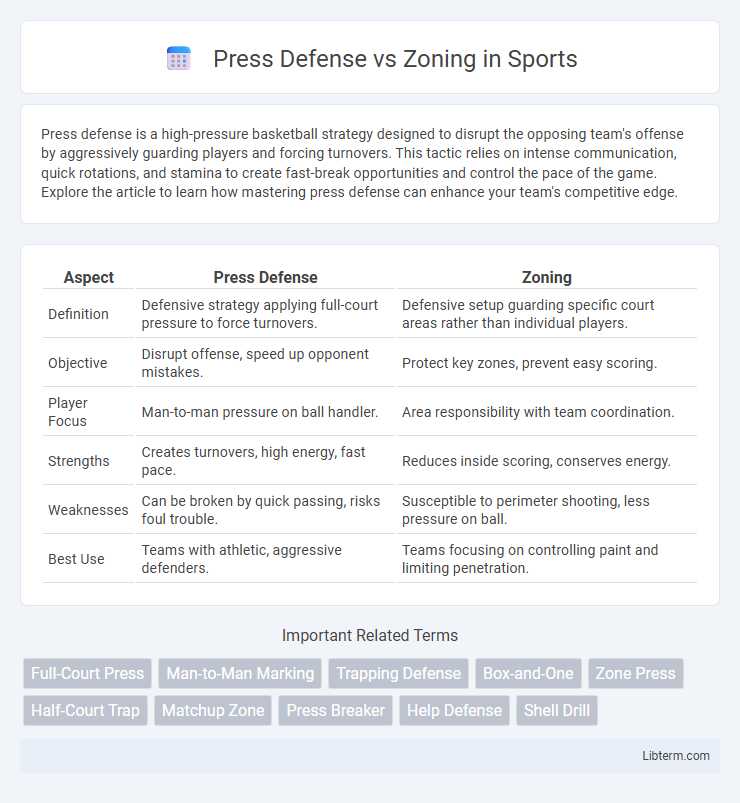Press defense is a high-pressure basketball strategy designed to disrupt the opposing team's offense by aggressively guarding players and forcing turnovers. This tactic relies on intense communication, quick rotations, and stamina to create fast-break opportunities and control the pace of the game. Explore the article to learn how mastering press defense can enhance your team's competitive edge.
Table of Comparison
| Aspect | Press Defense | Zoning |
|---|---|---|
| Definition | Defensive strategy applying full-court pressure to force turnovers. | Defensive setup guarding specific court areas rather than individual players. |
| Objective | Disrupt offense, speed up opponent mistakes. | Protect key zones, prevent easy scoring. |
| Player Focus | Man-to-man pressure on ball handler. | Area responsibility with team coordination. |
| Strengths | Creates turnovers, high energy, fast pace. | Reduces inside scoring, conserves energy. |
| Weaknesses | Can be broken by quick passing, risks foul trouble. | Susceptible to perimeter shooting, less pressure on ball. |
| Best Use | Teams with athletic, aggressive defenders. | Teams focusing on controlling paint and limiting penetration. |
Understanding Press Defense: Definition and Key Concepts
Press defense is a basketball defensive strategy designed to apply intense pressure on the offensive team throughout the court, forcing turnovers and disrupting their rhythm. It involves aggressive, close-guarding tactics that aim to trap ball handlers and limit passing options, making it difficult for the offense to advance the ball effectively. Key concepts include full-court or half-court pressure, coordinated team efforts in communication and quick rotations, and the emphasis on speed and anticipation to capitalize on forced errors.
What is Zoning in Basketball Defense?
Zoning in basketball defense is a strategy where each defender is responsible for guarding a specific area of the court rather than a single opponent. This approach aims to protect key zones, disrupt passing lanes, and force the offense into difficult shots by maintaining strong positioning and communication. Effective zoning requires players to anticipate ball movement and collaborate to close gaps, making it a flexible alternative to man-to-man or press defenses.
Core Differences Between Press Defense and Zoning
Press defense aggressively applies full-court pressure, aiming to force turnovers and disrupt the opponent's ball movement by closely guarding individual players. Zoning defense assigns players to specific areas on the court, focusing on protecting key zones and limiting inside scoring opportunities rather than marking opponents man-to-man. The core difference lies in press defense's emphasis on direct, high-intensity opponent engagement versus zoning's strategic spatial coverage and collective positioning.
Tactical Advantages of Press Defense
Press defense increases defensive pressure by forcing turnovers and disrupting opponent's offensive rhythm through close man-to-man coverage. It maximizes the use of court space, making it difficult for opponents to find passing lanes or set up plays, which leads to faster transition opportunities. The aggressive nature of press defense also tires out opponents, creating both physical and mental advantages over the course of the game.
Strengths and Limitations of Zoning
Zoning defenses excel in controlling specific court areas, effectively preventing penetration and forcing outside shots, which is particularly advantageous against teams with weak perimeter shooters. Their strength lies in conserving player energy and creating challenging passing lanes, disrupting offensive rhythm. However, zoning's limitations include vulnerability to teams with strong outside shooting, difficulty in rebounding due to shared box responsibilities, and susceptibility to offensive players exploiting gaps between zones.
When to Use Press Defense vs. Zoning
Use press defense to disrupt opponent's ball handlers, create turnovers, and increase game tempo, especially when facing teams with weak ball control or during late-game situations needing quick stops. Choose zoning defense to protect the paint, force outside shots, and conserve player energy, particularly against teams with strong individual scorers or poor perimeter shooting. Coaches deploy press defense to apply pressure across the full court and zone defense to enhance help defense and rebounding effectiveness.
Impact on Player Stamina and Team Dynamics
Press defense demands intense physical exertion, significantly increasing player fatigue due to continuous pressure and rapid movements, while zoning allows for more controlled energy expenditure by focusing on area coverage rather than constant man-to-man engagement. The high stamina requirement in press defense can lead to quicker player exhaustion, potentially reducing effectiveness late in games, whereas zoning supports sustained defensive intensity by conserving energy. Team dynamics in press defense rely heavily on communication and coordination to trap opponents efficiently, while zoning emphasizes spatial awareness and positional discipline, fostering a different type of collective responsiveness.
Common Mistakes in Implementing Press Defense
Common mistakes in implementing press defense include poor communication, which leads to players getting stuck or leaving gaps for easy passes. Many teams fail to maintain proper spacing, causing defenders to cluster and allowing opponents to break the press. Additionally, neglecting to apply consistent pressure on the ball handler results in ineffective traps and quick offensive escapes.
Effective Strategies for Breaking a Press or Zone
Effective strategies for breaking a press defense include quick ball movement, precise passing, and exploiting gaps through dribble penetration to disrupt defensive pressure. When attacking a zone defense, players should emphasize sharp ball reversals, timely off-ball cuts, and spacing to stretch defensive zones and create open shooting opportunities. Utilizing screens and flash cuts against zones further destabilizes defenders, opening lanes for efficient scoring chances.
Choosing the Right Defensive Scheme: Factors to Consider
Choosing the right defensive scheme between press defense and zoning depends on factors such as opponent's ball-handling skills, team athleticism, and communication abilities. Press defense demands high stamina and quick reactions to disrupt offensive plays, making it effective against teams with weaker guards. Zoning allows teams to protect the paint and manage rebounding better but requires strong spatial awareness and coordinated rotations to counter perimeter shooting threats.
Press Defense Infographic

 libterm.com
libterm.com